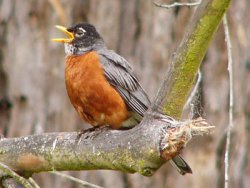
Courtesy US NPS
Will Elder, Photographer
NPS American Robin
Isn’t it interesting how shopping centers and housing developments are named after things that used to be: Fair Meadows Court, Rustic Drive, White Pines Lane, Riverwoods, Apple blossom Circle. There is one place that is named for its current occupants: Robin Street.
The American Robin is one of the most adapted birds to human development. It is also one of the most recognized. Robin redbreast is found not only by the stream, but in back yards, and city parks. We see them hopping across lawns, cocking their heads to see close up and picking out juicy worms. They also feast on cherries and other fruits. They can be seen and heard high in trees or on house peaks identifying their territory. Think about how they were in the past, pulling worms from a meadow and eating native berries. They actually have it better now.
They interact near us most often during breeding season. Robins build nests in trees or on sheltered ledges and platforms on buildings.
Both parents work to build the nest from sticks, thread, mud, and other available materials. The grass inner lining is soft against a woven-mud-covered bowl. Nest building is completed about 10 days before eggs are laid. The eggs are laid, one per day until a clutch of 3 or 4 fill the nest. The eggs define the pale blue-green color “Robin’s egg blue”.
The female sets on the eggs about two weeks until the young hatch blind and featherless. Mother and more often the father feeds the young. In another two weeks they are fully feathered and trying their wings. While the male feeds the young the female can be building another nest. Robins can produce 2 or 3 broods a year.
The robin’s size and shape is so well known that they are used as a standard to compare other birds.
But its a rough life being a robin. Only 40 percent of the nests built successfully rear a brood. Of the young hatched, 25 percent live through November. Although a robin may live up to 14 years, in any given year, only about half of the robins alive will live until the next year. Lawn chemicals and uncontrolled pets are part of the robin’s equation of life and death. The population of robins turns over on average every 6 years.
Robins roost in groups, except during the season when the females are setting on the nest. Males always roost in groups. After breeding, the nestlings and females join the male flock. Flocks of robins don’t frequent backyards as much in winter as they do in the nesting season. Some robins migrate, but some also live year-round in the same location. Robins remain in flocks until the spring nesting season when they again divide up into pairs and return to parks, back yards and Robin street.
For Wild About Utah I’m Dick Hurren.
Credits:
Photo: Courtesy of National Park Service, US Department of the Interior www.nps.gov/prsf/naturescience/american-robin.htm
Text: Bridgerland Audubon Society
For More Information:
https://www.norcrossws.org/html/robins2.htm
Complete Birds of North America, Jonathan Alderfer, ed. National Geographic, 2006
https://www.learner.org/jnorth/tm/robin/NestBox.html
https://www.wild-bird-watching.com/Robins.html
https://www.dnr.state.md.us/wildlife/warobin.asp
https://www.birds.cornell.edu/AllAboutBirds/BirdGuide/American_Robin.html
Kelly, Patrick, A Moral Dilemma, Wild About Utah, June 29, 2020, https://wildaboututah.org/a-moral-dilemma/
Bengston, Anna, Robins in Winter, Wild About Utah, March 13, 2014, https://wildaboututah.org/robins-in-winter/
Bengston, Anna, American Robin, Wild About Utah, January 18, 2016, https://wildaboututah.org/american-robin-160118/
